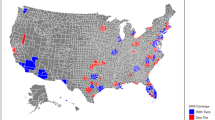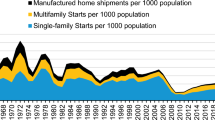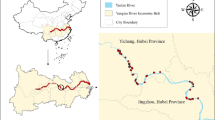Abstract
In an effort to reduce lead paint exposure in old homes, the residential lead paint hazard disclosure rule (Title X) was enacted in 1996 in the USA, which requires house sellers to disclose known lead-based paint hazards to buyers. The policy is designed to induce individuals’ improved maintenance behaviors through environmental information provisions. Minimizing the impact on housing prices is also the key component of the policy; a decline in the price of old homes because of the policy may lead to higher occupancy rates of the targeted low-income groups into lead paint risk homes. To explore the issue, this study examined whether the lead paint disclosure rule lowered values of old houses using the American Housing Survey data from 1993 to 2005 with the repeat sales method. The findings show the policy did not lower prices of old homes, as it intended.
Similar content being viewed by others
Notes
The AHS data used to compose the sales-based panel data are from 1993 to 2005. However, the final sales-based panel covers sales from 1985 to 2005 because purchase years of surveys trace back to 1985, not to the earliest survey time point, 1993.
Houses built before 1978 and after 1978 are systemically different in many aspects, which implies a serious selection problem. However, because an equivalent control group was not readily available (nation-wide introduction of Title X), this study tried to adopt a non-equivalent control group approach instead. Although this study tried to partly address the issue with control variables (e.g., maintenance cost variable), it is a key limitation of the analyses.
The repeat sales model assumes that the neighborhood characteristics are time-invariant. It is one of the major weaknesses of the standard repeat sales model. It would be highly desirable to identify the location of each house and to include neighborhood characteristics such as school quality. However, the public-use AHS does not reveal the detailed location of each house. Thus, this study estimated the model based on the assumption that neighborhood characteristics are constant.
The repeat sales model in this study is a similar form with the difference in difference model. While the difference in difference model is often used refer to the design to estimate a treatment effect with pooled cross-sectional data, the repeat sales model specifically puts an emphasis on tracking the same houses for pre- and post-groups.
I treated the houses that sold more than twice as multiple repeated sales pairs. Those houses must have a different error structure. However, this study followed a general repeat sales model approach without further consideration of the different error structures. This is one of the limitations of this analysis.
Among the baseline sales-based panel data with 7,135 houses, the repeat sales model dropped top-coded observations, non-single houses, observations for which the annual nominal rate of house price appreciation is greater than 50 %, and observations with unusually high levels of maintenance (maintenance expenditure more than twenty 5 % of the purchase price), as done in Harding et al.’s study. The annual maintenance expenditure variable is constructed by adding annual routine maintenance expenditures and project-specific costs.
The weak instruments test result (Stock-Yogo test: F statistic 19.042 > 10 % critical values 9.08) rejects the null hypothesis of weakness of the instruments. The over-identification test results (Hansen J test: Chi-square statistic 1.670, p value 0.433) show that the instrumental variables are valid.
References
Bae, H. (2012). Reducing environmental risks by information disclosure: Evidence in residential lead paint disclosure rule. Journal of Policy Analysis and Management, 31, 404–431.
Bailey, M. J., Muth, R. F., & Nourse, H. O. (1963). A regression method for real estate price index construction. Journal of the American Statistical Association, 58, 933–942.
Bennear, L. S., & Olmstead, S. M. (2008). The impact of the “right to know”: Information disclosure and the violation of drinking water standards. Journal of Environmental Economics and Management, 56, 117–130.
Brueckner, J. & Rosenthal, S. (2005). Gentrification and neighborhood cycles: Will America’s future downtowns be rich? Working paper, Syracuse University.
Centers for Disease Control and Prevention. (1997). Blood lead levels—United States, 1991–1994. Morbidity and Mortality Weekly Report, 46, 141–146.
Gayer, T., Hamilton, J., & Viscusi, W. K. (2002). The market value of reducing cancer risk: Hedonic housing prices with changing information. Southern Economics Journal, 69, 266–289.
Gendler, N. & Writer, S. (1997, Jan 18). Lead paint disclosure law isn’t expected to slow sales of older houses. Star Tribune, p. 4.H.
Goldman, L. R. (1997). Information the key to preventing childhood lead poisoning. Journal of Environmental Health, 59, 45–46.
Gyourko, J., & Saiz, A. (2003). Reinvestment in the housing stock: The role of construction costs and the supply side. Journal of Urban Economics, 55, 238–256.
Harding, J., Rosenthal, S., & Sirmans, C. F. (2007). Depreciation of housing capital, maintenance, and house price inflation: Estimates from a repeat sales model. Journal of Urban Economics, 61, 193–217.
Jacobs, D. E., Clickner, R., Zhou, J., Viet, S., Marker, D., Rogers, J., et al. (2002). The prevalence of lead-based paint hazards in U.S. housing. Environmental Health Perspectives, 110, 599–606.
Jin, G. Z., & Leslie, P. (2003). The effect of information on product quality: Evidence from restaurant hygiene grade cards. Quarterly Journal of Economics, 118, 409–451.
Jones, J. D. (2012). Primary prevention and health outcomes: Treatment of residential lead-based paint hazards and the prevalence of childhood lead poisoning. Journal of Urban Economics, 71, 151–164.
Kolp, P. W., Sattler, B., Blayney, M., & Sherwood, T. (1993). Comprehensibility of material safety data sheets. American Journal of Industrial Medicine, 23, 135–141.
Lanphear, B. P., Byrd, R. S., Auinger, P., & Schaffer, S. J. (1998). Community characteristics associated with elevated blood lead levels in children. Pediatrics, 101, 264–271.
Lee, B. S., Chung, E., & Kim, Y. H. (2005). Dwelling age, redevelopment, and housing prices: The case of apartment complexes in Seoul. Journal of Real Estate Finance and Economics, 30, 55–80.
Miceli, T. J., Pancak, K. A., & Sirmans, C. F. (1996). An economic analysis of lead paint laws. Journal of Real Estate Finance and Economics, 12, 39–75.
Palmquist, R. B. (1982). Measuring environmental effects on property values without hedonic regressions. Journal of Urban Economics, 11, 333–347.
Phillips, C., Wallace, B. C., Hamilton, C. B., Pursley, R. T., Petty, G. C., & Bayne, C. K. (1999). The efficacy of material safety data sheets and worker acceptability. Journal of Safety Research, 30, 113–122.
Robins, T. G., Hugentobler, M., Kaminski, M., & Klitzman, S. (1990). Implementation of the federal hazard communications standard: Does training work? Journal of Occupational Medicine, 32, 1133–1140.
Rosenthal, S. (2007). Old homes, externalities, and poor neighborhoods. A model of urban decline and renewal. Journal of Urban Economics, 63, 816–840.
Sargent, J. D., Brown, M. J., Freeman, J., Baily, A., Goodman, D. C., & Freeman, D. H. (1995). Childhood lead poisoning in Massachusetts communities: Its association with sociodemographic and housing characteristics. American Journal of Public Health, 85, 528–534.
Shilling, J. D., Sirmans, C. F., & Dombrow, J. F. (1991). Measuring depreciation in single-family rental and owner-occupied housing. Journal of Housing Economics, 1, 368–383.
Shimshack, J. P., Ward, M. B., & Beatty, M. (2007). Mercury advisories: Information, education and fish consumption. Journal of Environmental Economics and Management, 53, 158–179.
Simon, P. A., Leslie, P., Run, G., Jin, G. Z., Reporter, R., Aguirre, A., & Fielding, J. E. (2005). Impact of restaurant hygiene grade cards on foodborne-disease hospitalizations in Los Angeles County. Journal of Environmental Health, 67, 32–36.
United States Environmental Protection Agency (1995). Report on the HUD national survey of lead-based paint in housing. EPA/747-R95-003.
Yiin, L., Weber, J., Sannoh, S., & Rhoads, G. (2005). Efficacy of the community reinvestment act in promoting lead abatement. Journal of Environmental Health, 67(8), 44–48.
Author information
Authors and Affiliations
Corresponding author
Rights and permissions
About this article
Cite this article
Bae, H. The impact of the residential lead paint disclosure rule on house prices: findings in the American Housing Survey. J Hous and the Built Environ 31, 19–30 (2016). https://doi.org/10.1007/s10901-015-9441-x
Received:
Accepted:
Published:
Issue Date:
DOI: https://doi.org/10.1007/s10901-015-9441-x




